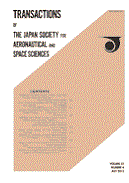Volume 46, Issue 153
Displaying 1-9 of 9 articles from this issue
- |<
- <
- 1
- >
- >|
-
Article type: RA
Subject area: Others
2003 Volume 46 Issue 153 Pages 133-142
Published: 2003
Released on J-STAGE: March 16, 2004
Download PDF (282K) -
Article type: RA
Subject area: Others
2003 Volume 46 Issue 153 Pages 143-149
Published: 2003
Released on J-STAGE: March 16, 2004
Download PDF (163K) -
Article type: RA
Subject area: Others
2003 Volume 46 Issue 153 Pages 150-154
Published: 2003
Released on J-STAGE: March 16, 2004
Download PDF (97K) -
Article type: RA
Subject area: Others
2003 Volume 46 Issue 153 Pages 155-162
Published: 2003
Released on J-STAGE: March 16, 2004
Download PDF (237K) -
Article type: RA
Subject area: Others
2003 Volume 46 Issue 153 Pages 163-172
Published: 2003
Released on J-STAGE: March 16, 2004
Download PDF (277K) -
Article type: RA
Subject area: Others
2003 Volume 46 Issue 153 Pages 173-179
Published: 2003
Released on J-STAGE: March 16, 2004
Download PDF (231K) -
Article type: RA
Subject area: Others
2003 Volume 46 Issue 153 Pages 180-185
Published: 2003
Released on J-STAGE: March 16, 2004
Download PDF (228K) -
Article type: RA
Subject area: Others
2003 Volume 46 Issue 153 Pages 186-194
Published: 2003
Released on J-STAGE: March 16, 2004
Download PDF (411K) -
Article type: RA
Subject area: Others
2003 Volume 46 Issue 153 Pages 195-205
Published: 2003
Released on J-STAGE: March 16, 2004
Download PDF (262K)
- |<
- <
- 1
- >
- >|
